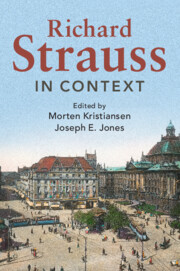Book contents
- Richard Strauss in Context
- Composers in Context
- Richard Strauss in Context
- Copyright page
- Contents
- Figures
- Notes on Contributors
- Preface
- Note on Translation
- Part I Family, Friends, and Collaborators
- Part II Career Stations
- Part III Cultural Engagement and Musical Life
- Part IV Professional and Musical Contexts
- Part V In History
- Chapter 25 Modernism
- Chapter 26 Traditionalism
- Chapter 27 World War I
- Chapter 28 Nazi Germany
- Chapter 29 Lateness
- Chapter 30 Reception
- Part VI Artifacts and Legacy
- Further Reading
- Appendix: Letters Bibliography
- Index
Chapter 25 - Modernism
from Part V - In History
Published online by Cambridge University Press: 08 October 2020
- Richard Strauss in Context
- Composers in Context
- Richard Strauss in Context
- Copyright page
- Contents
- Figures
- Notes on Contributors
- Preface
- Note on Translation
- Part I Family, Friends, and Collaborators
- Part II Career Stations
- Part III Cultural Engagement and Musical Life
- Part IV Professional and Musical Contexts
- Part V In History
- Chapter 25 Modernism
- Chapter 26 Traditionalism
- Chapter 27 World War I
- Chapter 28 Nazi Germany
- Chapter 29 Lateness
- Chapter 30 Reception
- Part VI Artifacts and Legacy
- Further Reading
- Appendix: Letters Bibliography
- Index
Summary
The European "modernism" of which Strauss was considered a representative in the 1890s and the "avant-garde" modernism that would exclude him in the new century differed significantly. Both are defined here as manifestations of, or critical reactions to, cultural and technological modernity. Varying shades of modernism are illustrated with reference to critical responses to Strauss and to his own 1907 essay "Is there an Avant-Garde in Music?" The length of Strauss’s career and the stylistic choices he made both reflect and problematize the once common notion that the history of the period’s music was simply one of evolutionary progress, which he first exemplified and then rejected. The varied and changing context of Strauss’s critical stance and compositional output resides not only in artistic ideas but also in politics and social practice in institutions like opera houses and concert halls and their audiences.
- Type
- Chapter
- Information
- Richard Strauss in Context , pp. 229 - 237Publisher: Cambridge University PressPrint publication year: 2020

